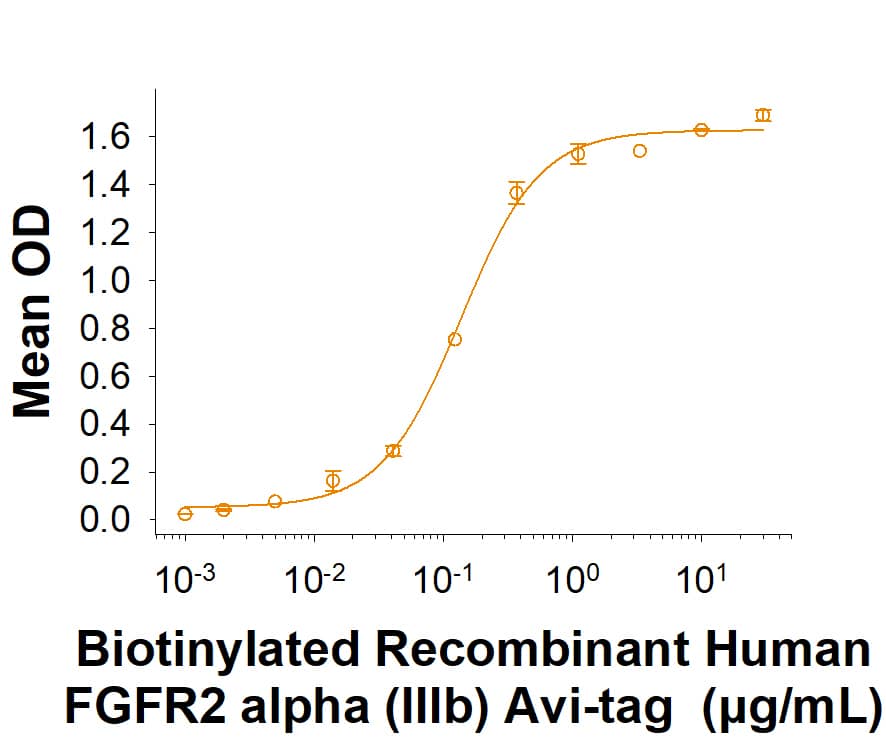Recombinant Human FGFR2 alpha (IIIb) Fc Avi-tag Protein, CF
R&D Systems, part of Bio-Techne | Catalog # AVI663

Key Product Details
Source
Accession #
Structure / Form
Biotinylated via Avi-tag
Conjugate
Applications
Product Specifications
Source
| Human FGFR2 Alpha (IIIb) (Arg22-Glu378) Accession # CAA39644.1 |
IEGRMD | Human IgG1 (Pro100-Lys330) |
Avi-tag |
| N-terminus | C-terminus | ||
Purity
Endotoxin Level
N-terminal Sequence Analysis
Predicted Molecular Mass
SDS-PAGE
Activity
Biotinylated Recombinant Human FGFR2 alpha (IIIb) Fc Chimera Avi-tag (Catalog # AVI663) binds Recombinant Human FGF acidic/FGF1 (aa 16-155) Protein (Catalog # 232-FA) with an ED50 of 0.0500-0.500 μg/mL.
Scientific Data Images for Recombinant Human FGFR2 alpha (IIIb) Fc Avi-tag Protein, CF
Biotinylated Recombinant Human FGFR2 alpha (IIIb) Fc Chimera Avi-tag Protein Binding Activity.
Measured by its binding ability in a functional ELISA. Biotinylated Recombinant Human FGFR2 alpha (IIIb) Fc Chimera Avi-tag Protein (Catalog # AVI663) binds Recombinant Human FGF acidic/FGF1 (aa 16-155) Protein (232-FA) with an ED50 of 0.0500-0.500 μg/mLBiotinylated Recombinant Human FGFR2 alpha (IIIb) Fc Chimera Avi-tag Protein SDS-PAGE.
2 μg/lane of Biotinylated Recombinant Human FGFR2 alpha (IIIb) Fc Chimera Avi-tag Protein (Catalog # AVI663) was resolved with SDS-PAGE under reducing (R) and non-reducing (NR) conditions and visualized by Coomassie® Blue staining, showing bands at 100-112 kDa and 200-220 kDa, respectively.Formulation, Preparation and Storage
AVI663
| Formulation | Lyophilized from a 0.2 μm filtered solution in PBS with Trehalose. |
| Reconstitution | Reconstitute at 500 μg/mL in PBS. |
| Shipping | The product is shipped at ambient temperature. Upon receipt, store it immediately at the temperature recommended below. |
| Stability & Storage | Use a manual defrost freezer and avoid repeated freeze-thaw cycles.
|
Background: FGFR2 alpha
Fibroblast growth factors (FGFs) comprise a family of at least eighteen structurally related proteins that are involved in a multitude of physiological and pathological cellular processes, including cell growth, differentiation, angiogenesis, wound healing and tumorgenesis. The biological activities of the FGFs are mediated by a family of type I transmembrane tyrosine kinases which undergo dimerization and autophosphorylation after ligand binding. Four distinct genes encoding closely related FGF receptors, FGF R1 - 4, are known. All four genes for FGF Rs encode proteins with an N-terminal signal peptide, three immunoglobulin (Ig)-like domains, an acid-box region containing a run of acidic residues between the IgI and IgII domains, a transmembrane domain and the split tyrosine-kinase domain. Multiple forms of FGF R1 - 3 are generated by alternative splicing of the mRNAs. A frequent splicing event involving FGF R1 and 2 results in receptors containing all three Ig domains, referred to as the alpha isoform, or only IgII and IgIII, referred to as the beta isoform. Only the alpha isoform has been identified for FGF R3 and FGF R4. Additional splicing events for FGF R1 - 3, involving the C-terminal half of the IgIII domain encoded by two mutually exclusive alternative exons, generate FGF receptors with alternative IgIII domains (IIIb and IIIc). A IIIa isoform which is a secreted FGF binding protein containing only the N-terminal half of the IgIII domain plus some intron sequences has also been reported for FGF R1. Mutations in FGF R1 - 3 have been found in patients with birth defects involving craniosynostosis. The complex patterns of expression of these receptors as well as the specificity of their interactions with the various FGF ligand family members are under investigation. Our Avi-tag Biotinylated Human FGFR2 alpha (IIIb) Fc Chimera features biotinylation at a single site contained within the Avi-tag, a unique 15 amino acid peptide. Protein orientation will be uniform when bound to streptavidin-coated surface due to the precise control of biotinylation and the rest of the protein is unchanged so there is no interference in the protein's bioactivity.
References
- Galzie, Z. et al. (1997) Biochem. Cell Biol. 75:669.
- Burke, D. et al. (1998) Trends Biochem. Sci. 23:59.
Long Name
Alternate Names
Gene Symbol
UniProt
Additional FGFR2 alpha Products
Product Documents for Recombinant Human FGFR2 alpha (IIIb) Fc Avi-tag Protein, CF
Product Specific Notices for Recombinant Human FGFR2 alpha (IIIb) Fc Avi-tag Protein, CF
For research use only

